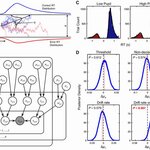Vision

The retina is the neural tissue in the back of the eye that initiates vision. It is responsible for receiving light signals and converting them into neurologic signals, which are then transmitted via the optic nerve to the brain so that we can see.
Mutations that disrupt vision by damaging the retina and optic nerve have been identified in more than 200 genes. This genetic diversity made genetic diagnostic testing difficult until the recent development of high throughput genomic techniques.
The Genetic Eye Disease (GEDi) test includes all of the genes known to harbor mutations that cause…

The Six Billion Dollar Man is getting a little bit closer, not just to movie theaters, but in real life.
A new development toward a prosthetic retina could help counter conditions that result from retinal degeneration, a life-altering health issue for many people, especially as they age.
Yael Hanein and colleagues point out that a growing range of medical devices has become available to treat conditions, including visual impairment, that involve sending sensory signals to the brain. Patients with one type of eye disorder called age-related macular degeneration (AMD), for example, could…

A new test may help eliminate onchocerciasis, commonly known as river blindness, which is a leading cause of preventable blindness in Africa. The SD BIOLINE Onchocerciasis IgG4 antibody-based test
is manufactured and distributed by Standard Diagnostics, Inc. and designed for use in disease surveillance.
Onchocerciasis is caused by a parasitic worm transmitted to humans through the bite of the blackfly. It causes itching, skin disfiguration, and, with chronic exposure, permanent blindness. Globally, an estimated 120 million people are at risk for river blindness, and 18 million are infected.…

During last night's World Series game between the San Francisco Giants and the Kansas City Royals, the batter dropped down a surprise bunt and sprinted to first base. The umpire called him safe and slow motion replay showed he had beaten the throw by mere inches. A good runner will make it from home to first in 5 or 6 seconds so seeing the foot hit the bag before the ball reached the glove was an amazing feat of ocularity.
Researchers believe they can make that skill the rule rather than the exception. KU Leuven and UEFA have embarked on a four-year project expand and fine-tune a web-…

Credit: Tobyotter via flickr
By: Nala Rogers, Inside Science
(Inside Science) -- The spider's iconic leggy shape can abruptly yank our attention, even when we’re focused on something else, according to a new study. Other shapes such as houseflies and hypodermic needles don’t draw our attention in the same way. This suggests that spiders may be hard-wired into our visual systems, helping us avoid a threat that our ancestors faced for millions of years.
“You can really think of it as sort of a computational circuit that you can program: When you detect a small little mass with radiating…

We assume that we can see the world around us in sharp detail but our eyes only process a fraction of our surroundings precisely.
In a series of experiments, psychologists at Bielefeld University investigated how the brain fools us into believing that we see in sharp detail. They find that our nervous system uses past visual experiences to predict how blurred objects would look in sharp detail.
Its central finding is that our nervous system uses past visual experiences to predict how blurred objects would look in sharp detail.
A thumbnail at the end of an outstretched arm: This is the area…

Almost 2 million Americans have an advanced form of age-related macular degeneration (AMD) and about 100,000 are blind from the disease. In AMD, cells in the retina, that layer of tissue in the back of the eye, begin to break down. What was once sharp central vision becomes blurry.
Why do some people get it and others don't? Family history is a factor but we are all taking a gamble as we age. Studies have shown that if you don't have signs by age 60, you are unlikely to get it. Why are some older people in a (pardon the pun) gray area, with no genetic history yet still likely to…

Taking daily supplements of selenium and/or vitamin E appears to have no significant effect on the development of age-related cataracts in men, according to new findings from the Selenium and Vitamin E Cancer Prevention Trial (SELECT) Eye Endpoints (SEE) Study.
Some research, including animal studies, has suggested that dietary nutrients can have an effect on the onset and progression of cataracts. Vitamin E and selenium are of particular interest.
The SEE study was an ancillary study of SELECT, a randomized placebo-controlled trial of selenium, vitamin E and a combination of the two…

A new paper believes it can measure the precision with which people make decisions - by pupil size before they are presented with any information.
Spontaneous, moment-to-moment fluctuations in pupil size predicted how a selection of participants varied in their successful decision making. A larger pupil size indicated poorer upcoming task performance, due to more variability in the decisions made once the relevant information was presented. The authors also found that certain individuals who had the largest pupils overall also tended to be the least consistent in their decisions.
But don…

Glaucoma, a condition where pressure builds from poor drainage of fluid from the anterior chamber of the eye, destroying retinal ganglion cells and eventually the optic nerve, is a leading cause of blindness in the U.S. but a cure has been elusive because the basis of the disease is poorly understood.
In glaucoma, the eye becomes like a bathtub that can't drain because the pipe is clogged. The clogged or defective vessel, known as Schlemm's canal, is part of the lymphatic system that is essential for drainage in the eye.
A new study for the first time identifies the molecular…